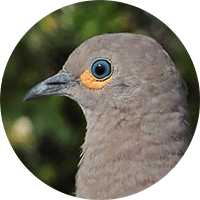Black-winged Ground-dove
The Black-winged Ground-dove (Metriopelia melanoptera). Read in Spanish
Appearance: The Black-winged Ground-Dove is characterized by its overall gray plumage with black wings. It has distinctive white bars on its wings and a noticeable black tail with white edges. The face is pale with a black band extending back from the eye. These doves have a slender build and a relatively small size compared to some other dove species.
Habitat: The Black-winged Ground-Dove is typically found in open habitats such as grasslands, shrublands, and rocky areas. They prefer altitudes ranging from high Andean regions to lower elevations in Colombia. This species can be found in both arid and semi-arid regions, as well as in mountainous areas with sparse vegetation.
Behavior: Black-winged Ground-Doves are often observed foraging on the ground for seeds, plants, and insects. They are known to be ground-dwelling birds, typically staying close to cover for protection. These doves may form small groups or pairs and are generally shy and inconspicuous in their behavior.
Breeding: Breeding behavior among Black-winged Ground-Doves may include courtship displays such as cooing calls and aerial displays. Nests are typically built on the ground or in low vegetation, where they lay a small clutch of eggs. Both parents share the responsibilities of caring for the eggs and raising the young doves.
Conservation Status: The conservation status of the Black-winged Ground-Dove in Colombia is currently categorized as "Least Concern" by the International Union for Conservation of Nature (IUCN).
Distribution
The Black-winged Ground-Dove (Metriopelia melanoptera).
Andean Region: The Andean region of Colombia includes the mountainous areas of the Andes mountain range that run through the western part of the country. The Black-winged Ground-Dove can be found in the high-altitude Andean regions, including the páramo ecosystems characterized by grasslands and shrubby vegetation.
Sub-Andean Region: The sub-Andean region of Colombia lies at lower altitudes compared to the Andean region, encompassing areas that transition from the Andean foothills to the lowland regions. This dove species may also inhabit the sub-Andean zones with favorable habitat conditions such as open grasslands and scrubby vegetation.
Northern Andes: Within the Colombian Andean region, the Black-winged Ground-Dove may be present in the northern Andes, which include departments such as Antioquia, Santander, and Norte de Santander. These areas offer a range of suitable habitats for the species, including rocky outcrops, grasslands, and open woodlands.
Central Andes: The central Andean region of Colombia, which includes departments like Boyacá, Cundinamarca, and Tolima, provides additional habitat for the Black-winged Ground-Dove. The species may be observed in the central Andean highlands where it occupies a variety of open and semi-open landscapes.
Southern Andes: In the southern Andean region of Colombia, encompassing areas such as Nariño and Putumayo, the Black-winged Ground-Dove may also be recorded. These regions offer diverse habitats suitable for the species, including mountainous terrain and open areas with scattered vegetation.
Taxonomy
The Black-winged Ground-Dove (Metriopelia melanoptera).
- Kingdom: Animalia
- Phylum: Chordata
- Class: Aves
- Order: Columbiformes
- Family: Columbidae
- Genus: Metriopelia
- Species: Metriopelia melanoptera
Vocalization
The vocalizations of the Black-winged Ground-dove (Metriopelia melanoptera), a species native to South America, consist primarily of a series of soft, low cooing sounds. These calls are often described as gentle and melodious. The exact vocalizations can vary based on the context and purpose, such as courtship displays, territorial defense, or communication between individuals.
Male Black-winged Ground-doves may produce more elaborate and longer calls during courtship to attract mates, while both males and females may use shorter calls for general communication. Additionally, these doves may also give alarm calls to warn other doves of potential danger in the vicinity.





